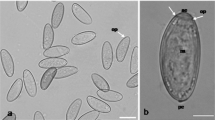Summary
Variations in the fine structure of the tegument of Taenia hydatigena have been shown to exist between areas on the same worm, and between worms of different ages. Microtriches on worms 20 days and older could be separated into three distinct types restricted to the following regions; the ‘immature-gravid’ region, the sucker region, and the surface of the rostellum. The absence of a microthrix border and distal cytoplasm at the distal end was a characteristic of worms up to 7 days old. Electron dense structures similar to rhabdomorphus organites were prominent in the distal cytoplasm of the scolex, but were absent from the distal cytoplasm of the ‘immature-gravid’ region. Structures considered to be elements of the sensory system were identified in all regions except the surface of the rostellum enclosed by the circlet of hooks.
Similar content being viewed by others
References
Béguin, F.: Etude au microscope electronique de la cuticule et de ses structures associees chez quelques cestodes. Essai d'histologie comparee. Z. Zellforsch. 72, 30–36 (1966).
Bråten, T.: An electron microscope study of the tegument and associated structures of the procercoid of Diphyllobothrium latum (L.). Z. Parasitenk. 30, 95–103 (1968a).
Bråten, T.: The fine structure of the tegument of Diphyllobothrium latum (L.) A comparison of the plerocercoid and adult stages. Z. Parasitenk. 30, 104–112 (1968b).
Collin, W. K.: Electron microscope studies of the muscle and hook systems of hatched oncospheres of Hymenolepis citelli. McLeod, 1933 (Cestoda: Cyclophyllidea) J. Parasit. 54, 74–88 (1968).
Featherston, D. W.: Taenia hydatigena: I. Growth and development of adult stage in the dog. Exp. Parasit. 25, 329–338 (1969).
Howells, R. E.: Electron-microscope and histochemical studies on the cuticle and subcuticular tissues of Moniezia expansa. Parasitology 55, (Suppl.) 20–21 (1965).
Karnovsky, M. L.: A formaldehyde-glutaraldehyde fixative of high osmalality for use in electron microscopy. J. Cell Biol. 27, 137 A-138 A (1965).
Laws, G. F., Featherston, D. W.: Bunamidine hydrochloride: Its effect in vitro on the tegument of Taenia hydatigena. Proc. Univ. Otago med. Sch. 48, 42–44 (1970).
Lee, D. L.: The structure and composition of the helminth cuticle. In: Advances in parasitology, vol. IV., B. Dawes, ed. New York: Academic Press 1966.
Morseth, D. J.: Ph. D. Thesis. University of Otago, Dunnedin, New Zealand 1965.
— The fine structure of the tegument of adult Echinococcus granulosus, Taenia hydatigena, and Taenia pisiformis. J. Parasit. 52, 1074–1085 (1966).
— Observations on the fine structure of the nervous system of Echinococcus granulosus. J. Parasit. 53, 492–500 (1967).
Porter, K.: Cytoplasmic microtubules and their functions. In: Principles of biomolecular organization, Ciba Foundation Symposium, G. E. W. Wolstenholme, ed. London: J. & A. Churchill Ltd. 1966.
Race, G. J., Martin, J. H., Larsh, J. E., Esch, G. W.: A study of the adult stage of Taenia multiceps (Multiceps serialis) by electron microscopy. J. Elisha Mitchell Sci. Soc. 82, 44–57 (1966).
Reynolds, E. S.: The use of lead citrate at high pH as an electron-opaque stain in electron microscopy. J. Cell Biol. 17, 208–213 (1963).
Rohde, K.: Sense receptors of Multicotyle parvisi Dawes 1941 (Trematoda, Aspidobothria). Nature (Lond.) 211, 820–822 (1966).
Siddiqui, E. H.: The cuticle of cysticerci of Taenia saginata, T. hydatigena, and T. pisiformis. Quart. J. micr. Sci. 104, 141–144 (1963).
Šlais, J.: The importance of the bladder for the development of the cysticercus. Parasitology 56, 707–713 (1966).
Smyth, J. D.: Observations on the scolex of Echinococcus granulosus, with special reference to the occurrence and cytochemistry of secretory cells in the rostellum. Parasitology 54, 515–526 (1964).
— Parasites as biological models. Parasitology 59, 73–91 (1969).
Threadgold, L. T.: An electron microscope study of the tegument and associated structures of Dipylidium caninum. Quart. J. micr. Sci. 103, 135–140 (1962).
— An electron microscope study of the tegument and associated structures of Proteocephalus pollanicoli: Parasitology 55, 467–472 (1965).
Author information
Authors and Affiliations
Rights and permissions
About this article
Cite this article
Featherston, D.W. Taenia hydatigena. Z. Parasitenk. 38, 214–232 (1972). https://doi.org/10.1007/BF00329599
Received:
Issue Date:
DOI: https://doi.org/10.1007/BF00329599




